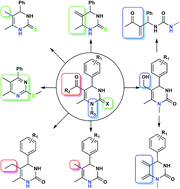Reduction of Biginelli compounds by LiAlH4: a rapid access to molecular diversity†
Abstract
Herein, the reduction of Biginelli compounds by LiAlH4 was investigated for the first time. The reduction of urea-derived dihydropyrimidinones yielded 80–95% of hydrogenolysis products (4-aryl-5-(m)ethyl-6-methyl-3,4-dihydropyrimidin-2(1H)-ones; 11 examples), while the reduction of N-1-methylated Biginelli compounds gave the corresponding alcohols (4-aryl-5-((1-)hydroxy(m)ethyl)-6-methyl-3,4-dihydropyrimidin-2(1H)-ones; 4 examples) in 70–80% yield. The obtained alcohols could be readily dehydrated to vicinal bis(exo-methylene) derivatives (4-aryl-1-methyl-5-(m)ethylene-6-methylene-tetrahydropyrimidin-2(1H)-ones; 4 examples) or isomerized to acyclic compounds (1-methyl-3-(1-aryl-2-methylene-3-oxobutyl)ureas; 2 examples) under mildly acidic conditions. The outcome of the reduction also depended on other structural features and reaction conditions such as: urea/thiourea and the type of 1,3-dicarbonyl compound, order of reagent addition, etc. LiAlH4-reduction of Biginelli compounds affords a rapid approach to a library of diverse compounds of apparent synthetic utility and possible biological interest. The mechanism of this reduction was discussed and additionally elucidated through deuteration experiments and pKa measurements.



 Please wait while we load your content...
Please wait while we load your content...